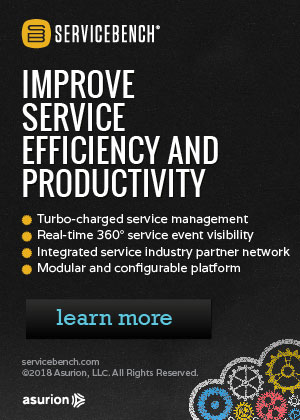Implementing a New Warranty Management Solution -- or Just Upgrading Your Existing Solution -- Can Make a Significant Improvement to Your Organization's Bottom Line.
Editor's Note: This column, written by Strategies For Growth
president and principal consulting analyst Bill Pollock, is the
latest in an ongoing series of contributed editorial columns.
Readers interested in authoring a contributed column in the
future can click here to see the Guidelines for Editorial
Submissions page.
By Bill Pollock, Strategies For Growth℠ president and principal consulting analyst.
After conducting its third in a series of annual Warranty Chain Management Benchmark Surveys, Strategies For Growth (SFG) president and principal consulting analyst, Bill Pollock, has put together a results package consisting of a white paper, a webinar, and a 2017 WCM Conference workshop on the subject of "How the Right Warranty Management Solution Can Help Improve Your Organization's Bottom Line."
According to Pollock, "The survey results reveal that nearly three-quarters (73%) of respondents believe effective warranty chain management to be at least 'very important' to the overall financial performance of the business, with just over a quarter (26%) believing it to be 'extremely important.' The results further reveal that this sense of importance is increasing substantially, year-over-year, as nearly one-third (30%) believe effective warranty chain management to be 'more important than one year ago,' compared to only 3% believing it to be 'less important' -- a ratio of roughly 10:1 citing 'more important' over 'less important.'"
Management Complacency?
However, while the importance of warranty management is sufficiently validated by the respondents to the firm's survey, a majority of warranty management solution users are not as duly impressed with the vendors that provide these services. For example, Pollock claims that "only 33% of respondents are presently 'satisfied' with the services and solutions provided by their primary warranty management solution vendors -- including a stunningly low 6%, or only one-out-of-16, who are 'extremely satisfied.' These percentages reflect a significant downtick from just one year earlier."
Rohit Lohan, senior product manager at Tavant Technologies Inc., agrees that many providers need to focus on meeting their customers' needs, requirements or expectations. He explains that "We are also seeing that many companies are not satisfied with their existing systems, as these systems and processes are not able to scale up to meet the change in market requirements. For this reason, we are constantly investing into improving our products and are making sure that our customers are benefiting from technical innovations happening in the warranty space."
On March 1, Tavant Technologies (a longtime sponsor of Warranty Week) hosted a complimentary hour-long webinar featuring the executive summary results of this survey. The webinar material was presented by both Bill Pollock and Rohit Lohan. To obtain newsarchived copies of both the webinar and the white paper, simply click here.
In the meantime, SFG has been gracious enough to share some of the key findings from its 2017 survey with our readers, as follows:
Claims Processing Automation
On the surface, while it may appear somewhat encouraging that 77% of respondents are currently running their warranty management operations using at least some "partially automated" processes (up from 70%, last year), this finding is, unfortunately, not actually that encouraging. In fact, only about one-in-five (20%) claim to have "fully automated" the warranty management processes currently in place at their respective businesses.
Figure 1
77% of Warranty Management Processes
Are at Least Partially Automated
(percent response)
By aggregating the various categories of partial-to-full automation, the current market base reflects one where, although 77% of respondents claim to be using at least some "partially automated" warranty management processes, there are a nearly equal amount (72%) where some manual processes are still being relied on.
However, regardless of the current state of automation -- or lack thereof -- Pollock says that within the broadly defined warranty claims management segment, "One thing is extremely clear: businesses plan to increase their annual warranty budgets over the next 12 months (i.e., through year-end 2017) and beyond. For some, about 19%, or roughly one-in-five, the increase will be modest, at less than 5%. However, another 12%, or about one-in-eight, plan to increase their respective budgets by between 5% and 9%. Still another 13% plan to increase their budgets by more than 10% - typically in the 20% to 25% range."
Figure 2
Annual Warranty Budgets Are Likely to
Increase* by Greater than a 2:1 Ratio
(percent response)
Implementing a New Warranty Management Solution
Roughly half (49%) of the survey respondents' organizations have either implemented a new warranty management solution, or upgraded their existing solution, within the past three years or less. Of this amount, about one-in-seven (15%) have implemented a new solution, while more than one-third (34%) have upgraded their existing solution. The remaining 51% are currently using warranty management solutions that are at least three years old, or older.
Figure 3
Nearly Half (49%) Have Implemented New,
or Upgraded Existing, Warranty Management Solutions
in the Past Three Years or Less
(percent response)
Pollock affirms that "The survey research clearly shows that those organizations that have implemented new warranty management solutions have realized the greatest levels of performance improvement -- certainly, much greater than for those that have merely upgraded their existing warranty management solutions."
The Key Performance Indicators, or KPIs, that reflect the greatest improvements for each category of organization are as follows:
Warranty Claims Processing Time:
- 14% Performance improvement for new implementations
- 6% Performance improvement for upgrades
Supplier/Vendor Recovery (as a percent of Total Warranty Expense):
- 8% Performance improvement for new implementations
- 5% Performance improvement for upgrades
Customer-Focused Warranty Management Organizations
The respondents to the survey have also clearly identified the specific drivers that are pushing them to aspire to the attainment of higher levels of performance. In fact, they have provided responses that suggest there are three main clusters of factors that drive their respective businesses: Customer-focused, Product Quality-focused, and Cost/Revenue-focused -– in that order.
Figure 4
The Principal Market Drivers Are
Largely Customer-Focused, Followed by
Product Quality and Cost/Revenue
(percent response)
For example, among the customer-focused drivers, post-sale customer satisfaction issues (47%), the desire to improve customer retention (43%), and customer demand for improved warranty services (36%), are the top three drivers with respect to optimizing overall service performance. No other drivers are cited by more than just over one-quarter (28%) of respondents.
The next cluster of drivers is product quality-focused, and is represented solely by dealing with inferior/deficient product quality at 28%. The third cluster, cost/revenue-focused, is comprised of two closely-related drivers: product defect-related costs (26%), and an internal mandate to drive increased service revenues (23%). As such, the warranty chain management community has made it clear that it is squarely focused on, first, satisfying -- and retaining -- its customers; second, dedicated to improving product quality-related issues; and third, mandated to bring down costs and drive increased warranty revenues through improved warranty management services -- again, in that specific order.
As such, these results signify a return to the relative normalcy that has characterized the Warranty Chain Management segment over the past several years -- a return to focusing on customers, rather than spending most of their time and resources wrestling with cost reductions and other financial issues. Obviously, while financial considerations are still highly important, the industry focus has shifted back, as it always does, squarely on the customer's needs, requirements, preferences and expectations.
Please click this link for more information, to download a complimentary copy of the companion white paper to this article, or to access an newsarchived version of the March 1st webinar.
About the Author:

Bill Pollock is President & Principal Consulting Analyst at Strategies For Growth (SFG), the independent research analyst and services consulting firm he founded in 1992. Previously, Bill served as President & Chief Research Officer (CRO) at The Service Council; Vice President, Principal Analyst, heading up Aberdeen Group's Service Management Practice; and Managing Analyst, Services Industry at Gartner.
In 2015/16/17, Bill was named "One of the Twenty Most Influential People in Field Service" by Field Service News (UK); one of Capterra's "20 Excellent Field Service Twitter Accounts;" and one of Coresystems' "Top 10 Field Service Influencers to Follow." He writes monthly features for Field Service News, Field Service Digital and Field Technologies Online.
Bill may be reached at +1 (610) 399-9717 by phone, or at wkp@s4growth.com via email. Bill's blog is accessible at @PollockOnService and via Twitter at @SFGOnService.
| 













